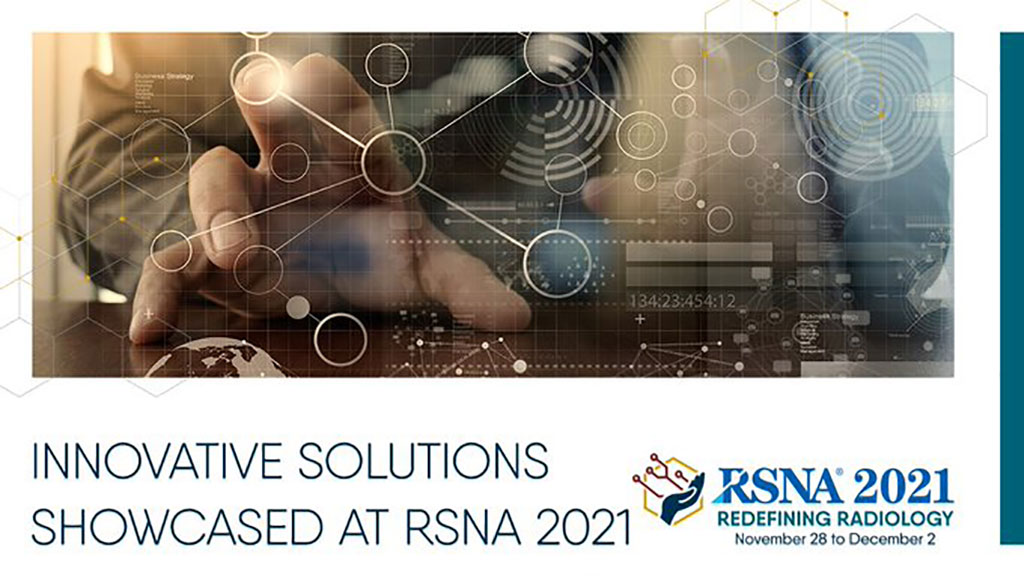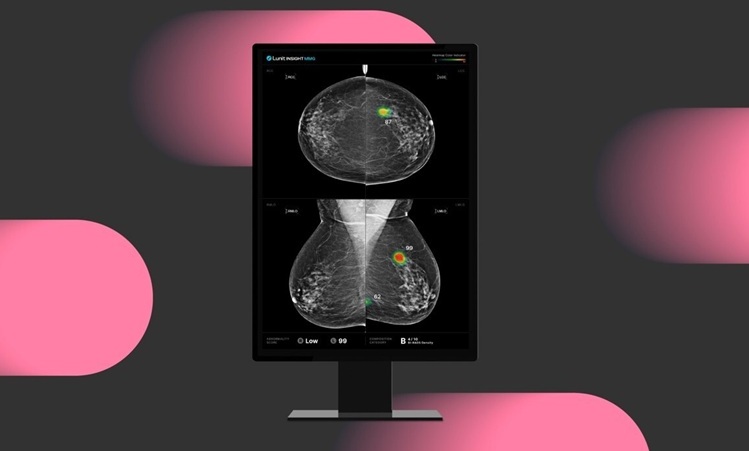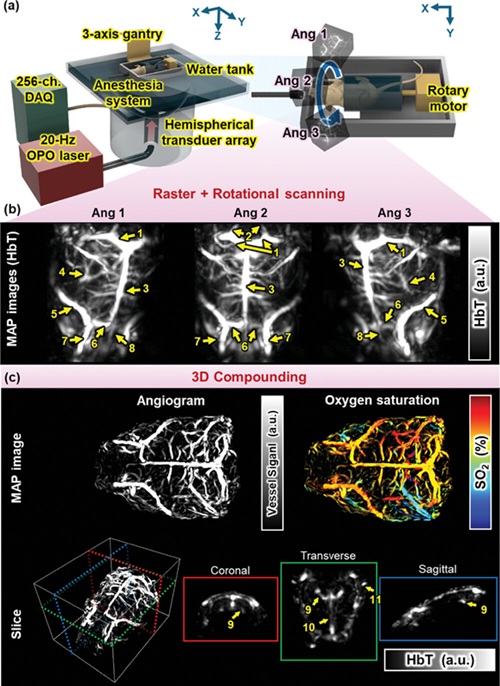Innovative Medical Imaging Research and New Technologies Make Their Debut at RSNA 2021
|
By MedImaging International staff writers Posted on 29 Nov 2021 |

Innovative medical imaging research and new technologies made their debut at RSNA’s 107th Scientific Assembly and Annual Meeting (RSNA 2021) held at McCormick Place in Chicago (Nov. 28-Dec. 2) by the Radiological Society of North America (Oak Brook, IL, USA).
More than 19,000 attendees registered to attend the event, with another 4,000 attending virtually. RSNA 2021: Redefining Radiology showcased new ideas and technologies that redefine what it means to work as a radiologist. The event required proof of COVID-19 vaccination from all in-person attendees, exhibitors, staff and contractors. In addition, face masks were mandatory while onsite at the meeting. Returning to McCormick Place after being held virtually in 2020, RSNA 2021 featured over 2,000 scientific presentations and posters, 1,500 education exhibits and more than 300 educational courses.
Popular features like the Image Interpretation Session and Case of the Day offered dynamic experiences for attendees. Another highlight was the rapid-fire “Fast 5” session, featuring brisk and engaging presentations on how medical insight and research are driving the future of radiology. The meeting also offered inspiring plenary sessions and more than 50 scientific presentations, lectures, courses and exhibits on diversity, equity and inclusion.
As the world’s largest medical imaging conference, RSNA 2021 provided the ultimate show floor with more than 500 exhibitors - including over 100 first-time RSNA exhibitors -demonstrating the latest medical imaging technologies in CT, MRI, artificial intelligence (AI), 3D printing, and more. The Technical Exhibition included the expansive AI Showcase and Theater, as well as the Imaging AI in Practice demonstration, the 3D Printing and Mixed Reality Showcase, Innovation Theater, First-time Exhibitor Pavilion, Educators Row, Recruiters Row and the Virtual Exhibitor Lounge.
Meeting extras included the “Zen Zone,” a Professional Portrait Studio and lively entertainment scheduled at various locations throughout the week, including the Grand Concourse, the Discovery Theater and the Connections Center. RSNA 2021 offered a wealth of industry programming on tap, including corporate symposia, “lunch and learns,” virtual industry and product presentations, vendor workshops and AI Theater presentations. RSNA’s robust virtual meeting component allowed those who are unable to attend in person and those who don’t meet the vaccine requirement to participate in the meeting remotely. The Virtual Meeting offered 100% of eligible meeting programming with on-demand content through April 30, 2022.
“The RSNA Board of Directors is extremely pleased by the advance registration numbers,” said RSNA President Mary C. Mahoney, MD. “After two challenging years, our attendees were ready to return to Chicago for the world’s leading imaging forum and to engage with the state-of-the-art technical exhibition. We are thrilled to provide them with an extraordinary meeting experience - featuring a comprehensive mix of science and education programming - while taking great care to protect their health and safety.”
Related Links:
Radiological Society of North America
Latest RSNA 2021 News
- Samsung Showcases Its Premium Diagnostic Imaging Solutions in Ultrasound, DR and Mobile CT at RSNA 2021
- Konica Minolta Introduces New High Performance Mobile X-Ray and High-Definition FPD at RSNA 2021
- Hologic Showcases Extensive Portfolio of Breast and Skeletal Health Products at RSNA 2021
- Visage Imaging Introduces Easy to Create Video Radiology Reports for Improved Patient Engagement at RSNA 2021
- Agfa Healthcare Launches its New Valory Digital Radiography (DR) Room at RSNA 2021
- GE Healthcare Introduces Industry’s First Modular, Scalable Computed Tomography (CT) Platform at RSNA 2021
- Fujifilm Launches New High Performance Velocity MRI System at RSNA 2021
- Bracco Celebrates Personalized and Precision Medicine Innovations at RSNA 2021
- PaxeraHealth Launches Ark Platform to Make AI More Accessible and Affordable at RSNA 2021
- IBM Watson Health Presents New Portfolio of Solutions Designed for Enterprise Imaging, Radiology and Cardiology at RSNA 2021
- Varex Exhibits Highly Innovative Photon Counting X-Ray Detectors at RSNA 2021
- Carestream Showcases Enhanced DR Room Imaging and AI Innovations at RSNA 2021
- Guerbet Showcases Comprehensive Range of Imaging Products, Solutions, and Services for Diagnostic Imaging at RSNA 2021
- Sectra Highlights Brilliant Radiology Workflows at RSNA 2021
- Barco Presents Solutions for Mammography, Remote Radiology Reading, Interventional Radiology and QA at RSNA 2021
- Siemens Unveils World’s First Photon-Counting CT at RSNA 2021
Channels
Radiography
view channel
Higher Chest X-Ray Usage Catches Lung Cancer Earlier and Improves Survival
Lung cancer continues to be the leading cause of cancer-related deaths worldwide. While advanced technologies like CT scanners play a crucial role in detecting lung cancer, more accessible and affordable... Read more
AI-Powered Mammograms Predict Cardiovascular Risk
The U.S. Centers for Disease Control and Prevention recommends that women in middle age and older undergo a mammogram, which is an X-ray of the breast, every one or two years to screen for breast cancer.... Read moreMRI
view channel
Ultra-Powerful MRI Scans Enable Life-Changing Surgery in Treatment-Resistant Epileptic Patients
Approximately 360,000 individuals in the UK suffer from focal epilepsy, a condition in which seizures spread from one part of the brain. Around a third of these patients experience persistent seizures... Read more
AI-Powered MRI Technology Improves Parkinson’s Diagnoses
Current research shows that the accuracy of diagnosing Parkinson’s disease typically ranges from 55% to 78% within the first five years of assessment. This is partly due to the similarities shared by Parkinson’s... Read more
Biparametric MRI Combined with AI Enhances Detection of Clinically Significant Prostate Cancer
Artificial intelligence (AI) technologies are transforming the way medical images are analyzed, offering unprecedented capabilities in quantitatively extracting features that go beyond traditional visual... Read more
First-Of-Its-Kind AI-Driven Brain Imaging Platform to Better Guide Stroke Treatment Options
Each year, approximately 800,000 people in the U.S. experience strokes, with marginalized and minoritized groups being disproportionately affected. Strokes vary in terms of size and location within the... Read moreUltrasound
view channel
Tiny Magnetic Robot Takes 3D Scans from Deep Within Body
Colorectal cancer ranks as one of the leading causes of cancer-related mortality worldwide. However, when detected early, it is highly treatable. Now, a new minimally invasive technique could significantly... Read more
High Resolution Ultrasound Speeds Up Prostate Cancer Diagnosis
Each year, approximately one million prostate cancer biopsies are conducted across Europe, with similar numbers in the USA and around 100,000 in Canada. Most of these biopsies are performed using MRI images... Read more
World's First Wireless, Handheld, Whole-Body Ultrasound with Single PZT Transducer Makes Imaging More Accessible
Ultrasound devices play a vital role in the medical field, routinely used to examine the body's internal tissues and structures. While advancements have steadily improved ultrasound image quality and processing... Read moreNuclear Medicine
view channel
Novel PET Imaging Approach Offers Never-Before-Seen View of Neuroinflammation
COX-2, an enzyme that plays a key role in brain inflammation, can be significantly upregulated by inflammatory stimuli and neuroexcitation. Researchers suggest that COX-2 density in the brain could serve... Read more
Novel Radiotracer Identifies Biomarker for Triple-Negative Breast Cancer
Triple-negative breast cancer (TNBC), which represents 15-20% of all breast cancer cases, is one of the most aggressive subtypes, with a five-year survival rate of about 40%. Due to its significant heterogeneity... Read moreGeneral/Advanced Imaging
view channel
AI Model Significantly Enhances Low-Dose CT Capabilities
Lung cancer remains one of the most challenging diseases, making early diagnosis vital for effective treatment. Fortunately, advancements in artificial intelligence (AI) are revolutionizing lung cancer... Read more
Ultra-Low Dose CT Aids Pneumonia Diagnosis in Immunocompromised Patients
Lung infections can be life-threatening for patients with weakened immune systems, making timely diagnosis crucial. While CT scans are considered the gold standard for detecting pneumonia, repeated scans... Read moreImaging IT
view channel
New Google Cloud Medical Imaging Suite Makes Imaging Healthcare Data More Accessible
Medical imaging is a critical tool used to diagnose patients, and there are billions of medical images scanned globally each year. Imaging data accounts for about 90% of all healthcare data1 and, until... Read more
Global AI in Medical Diagnostics Market to Be Driven by Demand for Image Recognition in Radiology
The global artificial intelligence (AI) in medical diagnostics market is expanding with early disease detection being one of its key applications and image recognition becoming a compelling consumer proposition... Read moreIndustry News
view channel
GE HealthCare and NVIDIA Collaboration to Reimagine Diagnostic Imaging
GE HealthCare (Chicago, IL, USA) has entered into a collaboration with NVIDIA (Santa Clara, CA, USA), expanding the existing relationship between the two companies to focus on pioneering innovation in... Read more
Patient-Specific 3D-Printed Phantoms Transform CT Imaging
New research has highlighted how anatomically precise, patient-specific 3D-printed phantoms are proving to be scalable, cost-effective, and efficient tools in the development of new CT scan algorithms... Read more
Siemens and Sectra Collaborate on Enhancing Radiology Workflows
Siemens Healthineers (Forchheim, Germany) and Sectra (Linköping, Sweden) have entered into a collaboration aimed at enhancing radiologists' diagnostic capabilities and, in turn, improving patient care... Read more




















